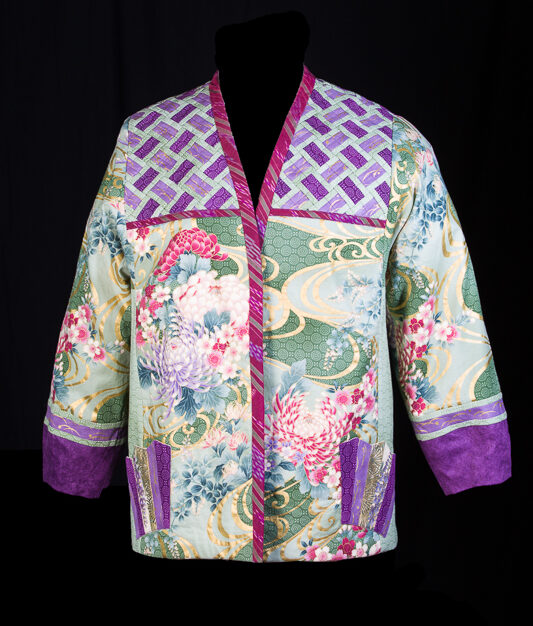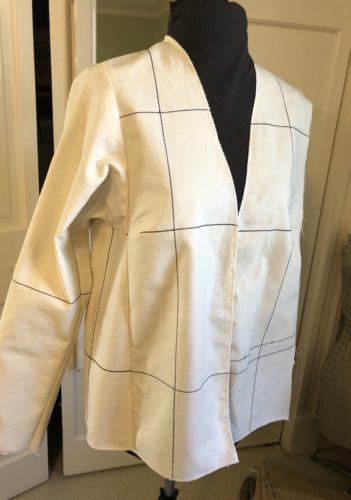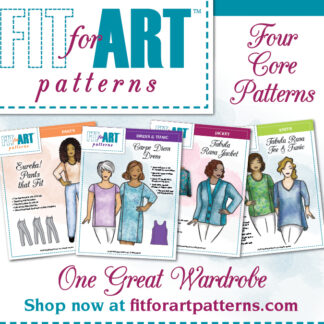
Have you wondered why we make such a fuss about the grainlines and horizontal balance lines on Fit for Art’s patterns? Maybe you’ve seen pictures of the fitting shells made for the Tabula Rasa Jacket pattern and wondered why the conspicuous lines are drawn on them. Maybe you are working with one of our core patterns for the first time and wondered if you really need to bother with tracing all those lines onto your mock-up. Or maybe you downloaded one of our digital patterns onto copy paper and are tempted not to bother tracing all the horizontal balance lines (HBLs) onto a tissue pattern. Read on to understand just how useful and important HBLs are to your sewing and fitting experience!


Garment sewists are accustomed to seeing grainlines on patterns and understand that they are important for making sure the pattern is laid out and cut correctly to ensure that the fabric will hang as desired in the finished garment. Drawing this grainline onto the mock-up fabric also helps to assess whether the garment hangs correctly on an individual. Add horizontal balance lines, and you’ve got a great tool for assessing the fit of any garment.
The Fitting Grid
Fit for Art provides a grid of grainlines and horizontal balance lines (we refer to them as HBLs) on its patterns to assist with fitting the garment. When a garment is fitting the body and hanging correctly, the grid of HBLs and grainlines run, respectively, parallel and perpendicular to the floor. This is why the lines are drawn conspicuously on the outside of our jacket and pant mock-ups, and why we encourage you to do so too. The lines are reference points for achieving a balanced fit on any shape body.
When the lines are pulled or skewed out of place, it indicates a need to adjust the fit of the garment to bring the grid back to parallel and perpendicular. The direction of the skew also points to where the adjustment needs to be made. In our online fitting resources, we rely on this grid to direct a sewer’s fitting adjustments. The fit adjustments are tested first on the mock-up so you can assess the effect of the changes on the fitting grid. After fitting is complete, use the grid to help record the adjustments on your patterns for future garments. For example, illustrations on our free download Common Fitting Adjustments for the Tabula Rasa Jacket PDF help the sewer interpret what the skewed lines are indicating; the accompanying text explains how to make a corresponding adjustment to restore the grid and then how to record the adjustment on the paper pattern. The instruction book that accompanies the Eureka! Pants that Fit pattern contains a similar series of illustrations and fitting directions based on the grid. You can see these principles in action in several of our Video Tutorials. Read more in previous blog posts about making and fitting with a jacket mock-up and pants mock-up.
Use It for Future Adjustments
After the initial fitting of a pattern, keep your mock-up, as well as the adjusted pattern, for future uses. When your body changes shape or size, you can put the mock-up back on to help assess what fitting changes are needed and revise the pattern accordingly.
If you want to shape a pattern for a particular fabric or occasion, for example using our free download Guidelines for a Trimmer Fitting Tabula Rasa Jacket PDF, you can baste the proposed adjustments into the mock-up and try it on to test the fit and look before cutting out the new garment. This would also work to test alterations to the shape and fit of a sleeve or pant leg.
Use It to Design
We find the grid of grainlines and HBLs useful for design as well as fitting. The HBLs on the jacket pattern can be used as reference points to create facings at the neckline and to divide the front or back pattern horizontally, such as to create a yoke. The grainlines can be used as a reference point to divide the front or back vertically to mix fabrics or frame a special motif. The mock-up is a super tool for planning and assessing the placement of elements in a new garment by pinning or hanging motifs and fabrics onto your mock-up.



Essential for Variation and Detail Patterns
Fit for Art also relies on the grid of grainlines and HBLs when designing our style variation patterns for each of the core patterns. The gridlines are used as a reference point for aligning templates to the core patterns to create new pattern styles that you can be confident will still fit. A few examples:
- The Tabula Rasa Jacket’s V-shaped front is turned into an overlapping shirt front (Shirt Variations), center front zipper coat or hoodie (Rain or Shine Variations), or self-facing placket (Jean Jacket Variations).
- The Tabula Rasa Knit Tee’s U-shaped neckline is converted to ballet and boat neck (Wide Neckline Variations), scoop neck top, and center front or waterfall cardigan (Twin Set Variations).
- The Eureka! Pants Details series refers to the grid to help with conversion to a fly-front zipper, placement of pockets, and altering the silhouette of the pant legs.



See the Fitting Grid in Action

Join us in a class, workshop or sewing retreat to see the fitting grid in action or to work with Rae and Carrie on fitting your own Fit for Art Patterns. Check the event calendar for listings of currently scheduled Fit for Art classes and sewing retreats. Make sure you join our mailing list to receive the weekly blog post and monthly newsletter announcing new and upcoming events in your email. We hope to see you soon!
Happy Sewing, Carrie








